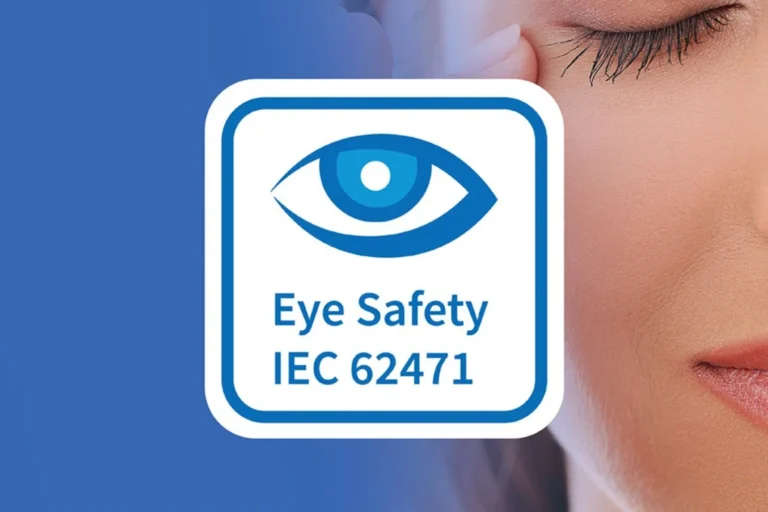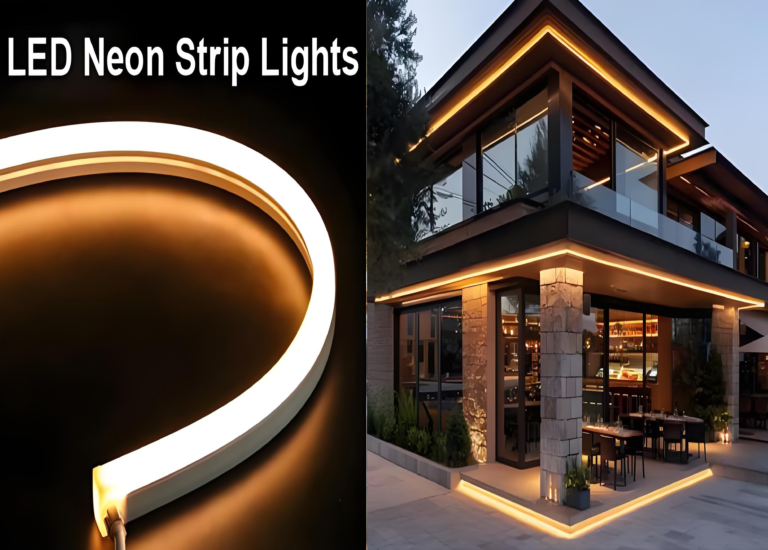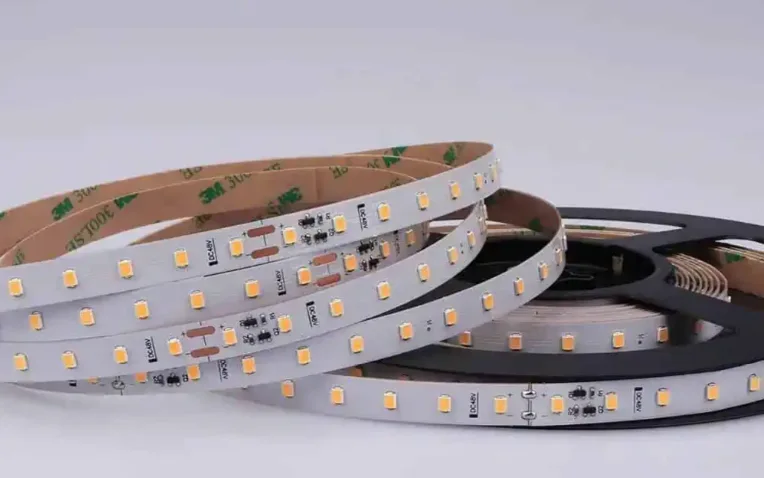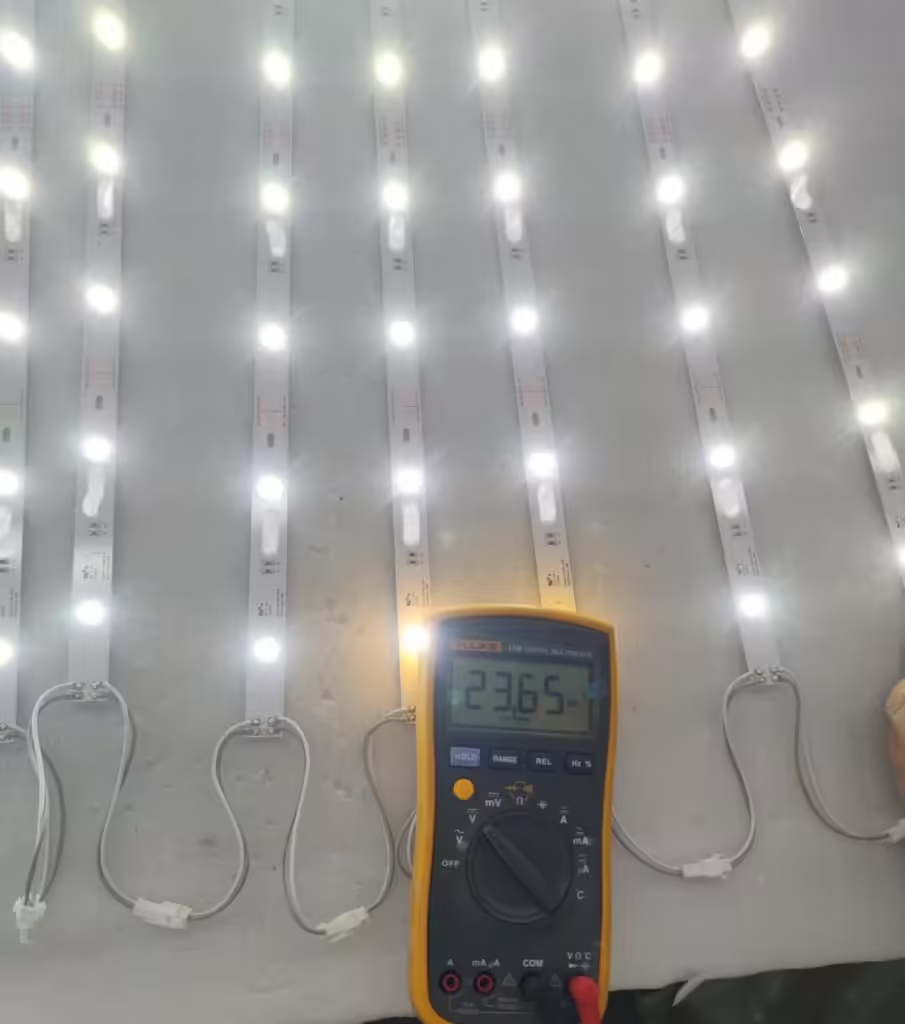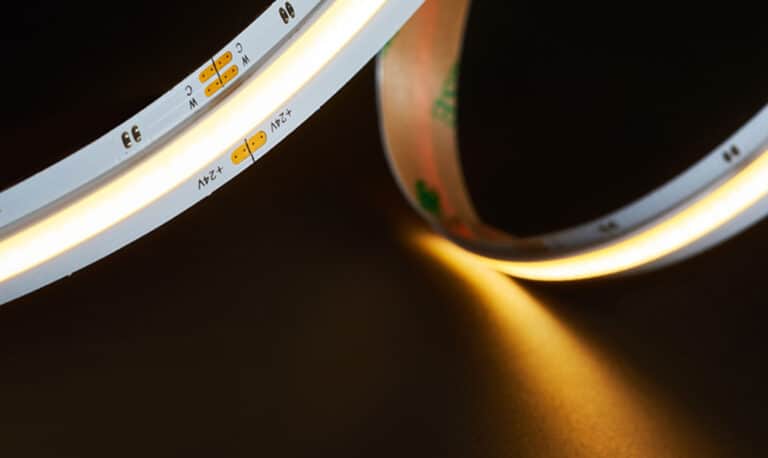다이나믹한 RGB 조명과 관련하여 대부분의 사람들은 저전압 DC 어드레서블 스트립을 생각합니다. 그러나 최근 몇 년 동안 더 많은 계약자와 조명 전문가가 대규모 야외 및 건축 프로젝트를 위해 AC 주소 지정 가능한 LED 스트립 조명을 선택하고 있습니다. 왜요? AC RGB 스트립은 전압 강하 없이 최대 50미터까지 작동할 수 있으므로 부피가 큰 전원 공급 장치가 필요하지 않으며 플러그 앤 플레이 편의성을 제공합니다. DC 스트립은 정밀한 제어와 유연성을 제공하지만 AC 버전은 특히 110V 또는 220V 지역에서 단순성, 거리 및 비용 효율성에서 승리합니다. 이 기사에서는 AC와 DC 주소 지정 가능한 LED 스트립의 주요 차이점을 살펴보고 다음 프로젝트에 적합한 선택을 결정하는 데 도움을 줍니다.

AC 주소 지정 가능한 LED 스트립 조명은 무엇입니까?
AC 주소 지정이 가능한 LED 스트립 조명은 저전압 전원 공급 장치 없이도 동적 조명 효과를 표시할 수 있는 고전압 RGB 스트립입니다. 110V 또는 220V AC 입력과 직접 작동하도록 설계된 이 스트립은 내장 정류기 회로를 사용하여 내부적으로 교류 전류로 교류를 변환하므로 일관되고 안전한 작동이 가능합니다.
외부 컨트롤러와 전원 어댑터가 필요한 표준 DC 어드레서블 스트립과 달리 AC RGB 스트립은 플러그 앤 플레이 키트로 제공되는 경우가 많기 때문에 광도 저하 없이 장거리 설치에 이상적입니다.
이 스트립은 일반적으로 반 주소가 가능합니다. 즉, 각 세그먼트(종종 1미터 또는 0.5미터)가 내장된 IC 유형에 따라 다른 색상 또는 추격 효과를 표시할 수 있습니다.
일반적인 IC 옵션은 다음과 같습니다.
SM16703/SM16716: 세그먼트 수준의 동적 효과를 지원합니다.
TM1934 또는 이와 유사한 것: 방수 실외 응용 분야에서 자주 사용됩니다.
내부 MCU 기반 IC: 특정 효과를 위해 AC 드라이버 모듈에 내장된 맞춤형 IC.
주요 기능:
110V 또는 220V로 직접 작동
롱 싱글 런 기능(최대 50m)
IP65–IP68 방수 옵션
옥외 또는 상업용 조명에 이상적인 설치가 간편한
Bulit-In 프로그램이 있는 컨트롤러 없이도 작동할 수 있습니다.
DC 주소 지정 가능한 LED 스트립 조명은 무엇입니까?
DC 주소 지정 가능 LED 스트립 조명은 외부 컨트롤러를 사용하여 픽셀 수준의 조명 제어를 허용하는 저전압 RGB 스트립입니다. 일반적으로 5V, 12V 또는 24V DC에서 작동하며 장식, 간판 및 애니메이션 조명 프로젝트에 널리 사용됩니다.
두 가지 주요 제어 유형이 있습니다.
SPI(직렬 주변기기 인터페이스):
복잡한 조명 효과 및 픽셀 제어에 이상적입니다. 각 LED(또는 그룹)에는 고유한 주소가 있습니다.
공통 ICS: WS2812B, WS2811, SK6812, UCS1903, APA102.
DMX(디지털 멀티플렉스):
무대, 이벤트 및 건물 외관 조명과 같은 전문 조명 시스템에 사용됩니다.
공통 ICS: TM512, TM1934, SM17512, UCS512C.
DC 주소 지정 스트립은 유연성, 부드러운 효과 및 정밀도를 제공하지만 컨트롤러와 전원 공급 장치가 필요합니다. 전압 강하 제한으로 인해 단거리에서 중간 길이의 달리기에 가장 적합합니다.
DC 어드레스 가능한 LED 스트립 조명에 대해 자세히 알아보려면 여기에서 자세한 가이드를 확인하세요. 픽셀 어드레서블 LED 스트립 비교: DMX512와 SPI

AC 대 DC 주소 지정 가능 LED 스트립: 차이점은 무엇입니까?
AC 및 DC 주소 지정 가능한 LED 스트립 조명 중에서 선택하는 것은 설치 단순성, 제어 정밀도, 안전성 또는 장거리 성능에 관한 것이든 상관없이 프로젝트의 요구 사항에 따라 다릅니다.
AC 주소 지정 가능한 스트립은 110V 또는 220V에 직접 연결하도록 설계되어 장거리 및 빠른 설치가 가장 중요한 실외 또는 대규모 프로젝트에 이상적입니다. 이 스트립은 일반적으로 세그먼트 수준의 효과(예: 50cm 또는 1m마다)를 제공하며 플러그 앤 플레이 컨트롤러와 함께 제공됩니다. 외부 전원 공급 장치가 필요하지 않으며, 눈에 띄는 밝기 감소 없이 한 번의 실행으로 최대 50미터까지 도달할 수 있습니다.
반면에 DC 어드레싱 스트립은 안전한 저전압 전력(5V/12V/24V)에서 작동하며 픽셀 수준의 제어를 제공합니다. 풍부한 애니메이션 효과를 지원하며 간판, 인테리어 디자인, 게임 설정 및 대화형 설치에 널리 사용됩니다. 그러나 외부 전원 공급 장치가 필요하고 몇 미터 후에 전압 강하가 문제가 되며 설치가 더 복잡합니다.
간단히 말해서 AC = 단순성과 거리인 반면 DC = 제어 및 정밀도.
| 기능 | AC 주소 지정 가능한 스트립 | DC 주소 지정 가능한 스트립 |
| 작동 전압 | 110V/220V AC | 5V / 12V / 24V DC |
| 제어 유형 | 세그먼트 수준(기본 효과) | 픽셀 레벨(SPI/DMX를 통한 정밀 제어) |
| 최대 실행 길이 | 최대 50미터 | 5~10m(전력 주입 필요) |
| 전원 공급 필요 | 아니오(내장 정류기) | 예(외부 드라이버 및 컨트롤러) |
| 설치 | 플러그 | 배선 및 설정이 필요합니다 |
| 안전 | 더 높은 전압 위험(보호 필요) | 저전압, 취급에 더 안전 |
| 유연성 | 강성 또는 반유연성 | 높은 유연성 |
| 일반적인 애플리케이션 | 야외 외관, 상업용 조명 | 간판, 애니메이션, 인테리어 장식 |
| 비용 효율성 | 장기간의 총비용 절감 | 액세서리로 인해 비용이 많이 듭니다. |
AC RGB 주소 지정 가능한 LED 스트립 조명의 장단점
모든 조명 솔루션과 마찬가지로 AC 주소 지정 가능한 RGB LED 스트립에는 장점과 한계가 있습니다. 이러한 사실을 이해하면 특히 대규모 또는 실외 조명 프로젝트에서 적합한 제품을 선택하는 데 도움이 될 수 있습니다.
장점:
장거리 연속 주행(최대 50m)
전원 주입 또는 신호 중계기가 필요하지 않습니다. 외관, 복도 또는 주변 윤곽을 구축하는 데 이상적입니다.
플러그 앤 플레이 설치
외부 DC 전원 공급 장치 또는 복잡한 배선이 필요하지 않습니다. 설치 노동과 시간을 절약하십시오.
시스템 비용 절감
액세서리(전원 공급 장치, 증폭기 등)가 적어 AC 스트립을 대규모 프로젝트에 더 저렴하게 사용할 수 있습니다.
높은 방수 옵션
많은 모델이 IP65–IP68 보호 기능을 갖추고 있어 비, 먼지 또는 눈이 내린 야외에서 사용하기에 적합합니다.
내장 제어 옵션
대부분의 스트립에는 색상 추적, 호흡 및 깜박임과 같은 동적 효과가 있는 기본 컨트롤러가 포함되어 있어 즉시 사용할 수 있습니다.
단점:
제한된 픽셀 제어
AC 스트립은 일반적으로 LED별 애니메이션이 아닌 세그먼트 기반 효과만 지원합니다. 정밀한 디자인이나 대화형 조명에는 적합하지 않습니다.
더 높은 전압 = 더 높은 안전 위험
110V 또는 220V에 직접 연결하려면 전기적 위험을 방지하기 위해 신중한 취급과 적절한 방수 밀봉이 필요합니다.
모양이 덜 유연하다
AC 스트립은 내부 회로 설계로 인해 DC 스트립보다 종종 더 뻣뻣해져서 굽히거나 단단히 구부러지기 어렵습니다.
근거리 설치에 적합하지 않음
안전 및 열 고려 사항으로 인해 AC RGB 스트립은 외부 또는 실외 설치에 더 적합합니다.
AC 주소 지정 가능한 LED 스트립은 어디에 사용됩니까?
긴 주행 길이, 방수 보호 및 플러그 앤 플레이 디자인 덕분에 AC 주소 지정 가능한 LED 스트립은 빠른 설치와 광범위한 커버리지가 핵심인 대규모 및 실외 프로젝트에서 널리 사용됩니다. 다음은 몇 가지 일반적인 응용 프로그램입니다.
1. 건물 외관 조명
AC RGB 스트립은 고층 건물, 상업 광장 및 건축 랜드마크의 개요를 설명하는 데 적합합니다. 릴당 최대 50미터의 릴로 배선 복잡성을 줄이면서 장거리에 걸쳐 동적 색상 효과를 제공합니다. IP67 등급 버전은 일년 내내 비와 바람을 견딜 수 있습니다.

2. 다리와 터널 장식
교량, 터널, 고가도로와 같은 인프라 프로젝트에서 AC 주소 지정 스트립은 최소한의 유지 관리로 생생한 선형 효과를 제공합니다. 고전압 입력은 도시 전력 시스템과 호환되며 방수 기능을 통해 노출된 환경에서 안전하게 사용할 수 있습니다.

3. 쇼핑몰 또는 상업 주변 조명
지붕선, 입구 또는 창 가장자리를 따라 사용되는 이 스트립은 건물의 야간 모습을 향상시키는 시선을 사로잡는 조명 애니메이션을 만들 수 있습니다. 내장 컨트롤러는 배선을 단순화하여 촉박한 마감 시간에 작업하는 계약자의 시간을 절약합니다.
4. 야외 축제 또는 휴가 설치
크리스마스, 새해 또는 도시 이벤트와 같은 임시 설치의 경우 AC 스트립을 사용하면 최소한의 액세서리로 빠른 설정이 가능합니다. 플러그인 디자인은 외부 드라이버가 필요하지 않으므로 계절 조명 계약자에게 이상적입니다.
AC 및 DC RGB LED 스트립 선택: 어떤 것이 필요합니까?
AC 및 DC 주소 지정 가능 RGB LED 스트립 중에서 결정할 때 올바른 선택은 프로젝트 목표, 설치 환경 및 예산에 따라 다릅니다. 각 유형에는 장점이 있습니다. 어느 것이 더 나은가가 아니라 어떤 유형이 귀하의 요구에 맞는가에 관한 것입니다.
다음과 같은 경우 AC RGB LED 스트립을 선택하십시오.
전압 강하 또는 전원 주입 없이 장거리 달리기(최대 50미터)를 설치해야 합니다.
이 프로젝트는 외관 조명, 간판 테두리 또는 조경 기능과 같은 실외 또는 상업용입니다.
더 적은 수의 구성 요소로 더 빠른 설치를 원합니다. 플러그 앤 플레이만 하면 됩니다.
110V 또는 220V 전원을 직접 사용하고 있으며 액세서리를 최소화하고 싶습니다.
세그먼트 수준의 제어 기능이 있는 비용 효율적인 대규모 조명을 선호합니다.
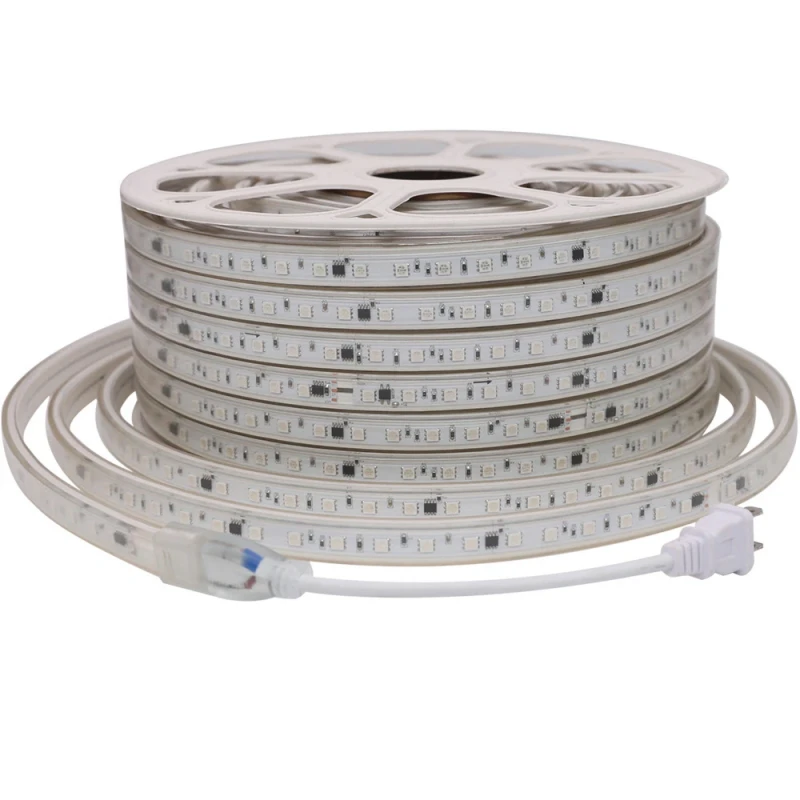
AC 110V/220V 주소 지정 가능한 LED 스트립 라이트
모델 번호: EAA10T060G
입력 전압: AC110V/220V
와트: 10W/m
LED 수량: SMD5050 60LED/m
색온도: 주소 지정 가능 RGB
IP 등급: IP68
절단 가능한 길이: 1000mm
길이: 50미터/롤
보증: 2년
가격: 3달러
다음과 같은 경우 DC RGB LED 스트립을 선택하십시오.
개별 LED 애니메이션이나 고급 효과와 같은 정확한 픽셀 제어가 필요합니다.
귀하의 응용 프로그램은 간판, 진열장 또는 게임실과 같은 실내 또는 장식입니다.
곡선, 모서리 또는 사용자 정의 모양에 유연하게 설치해야 합니다.
컨트롤러, 전원 공급 장치 및 프로그래밍에 대한 경험이나 지원이 있습니다.
조명은 DMX 기반 쇼 또는 SPI 효과와 같은 대화형 또는 크리에이티브 시스템의 일부입니다.
DC 주소 지정 가능한 RGB LED 스트립 라이트를 구입하려면 여기를 클릭하여 더 많은 제품을 확인하십시오. DC 주소 지정 가능한 스트립 라이트
한마디로:
AC = 더 간단하고 더 길며 실외
DC = 더 스마트하고 유연하며 상세한 제어
아직도 확신이 서지 않습니까? 하이브리드 접근 방식도 가능합니다. 일부 프로젝트에서는 주변 조명에 AC 스트립을 사용하고 초점 애니메이션 영역에 DC 스트립을 사용합니다.
110V/220V AC LED 스트립 조명을 안전하게 사용하는 방법
AC RGB LED 스트립은 편의성과 장거리 성능을 제공하지만 고전압(110V 또는 220V)에서 작동하므로 설치 및 사용 중에 안전에 더 많은 주의를 기울여야 합니다. 다음은 상업 및 실외 환경에서 안전하고 안정적인 작동을 보장하기 위한 주요 지침입니다.
1. 방수 커넥터와 엔드 캡 사용
IP65+ 방수 커넥터와 실리콘으로 채워진 엔드 캡으로 스트립의 양쪽 끝을 항상 밀봉하십시오. 이것은 특히 실외 또는 반개방형 설치에서 물의 유입 및 단락을 방지합니다.
2. 손이 닿지 않는 스트립 장착
고전압으로 인해 사람들이 직접 만질 수 있는 스트립을 배치하지 마십시오. 높은 벽, 천장, 처마를 따라 또는 디퓨저 뒤에 설치하여 위험을 줄입니다.
3. 인증 제품 선택
안전 표준을 준수하려면 CE, ETL 또는 UL 인증이 있는 스트립만 사용하십시오. 안정적인 성능을 위해서는 안정적인 내부 드라이버와 난연성 재료가 필수적입니다.
4. 누설 방지(RCD/RCBO) 사용
항상 전원 회로에 잔류 전류 장치(RCD) 또는 RCBO를 설치하십시오. 이 안전 스위치는 누출 또는 단락이 발생하면 즉시 전원을 차단하여 사람과 재산을 모두 보호합니다.
5. 작동 중 코일링을 피하십시오
과열을 유발할 수 있으므로 코일 또는 단단히 고리 상태에서 AC LED 스트립을 작동하지 마십시오. 알루미늄 또는 PVC 채널과 같은 방열 표면에 항상 완전히 펼쳐진 상태로 설치하십시오.
6. 모든 파워 포인트에 라벨을 붙이고 보호
모든 AC 연결 지점을 명확하게 표시하고 열 수축 슬리브 또는 절연 상자를 사용하여 노출된 단자를 보호하십시오. 습기와 파손으로부터 제어 상자와 전원 인터페이스를 보호하십시오.
이러한 예방 조치를 취하면 AC RGB 스트립 설치가 훌륭할 뿐만 아니라 안전하고 내구성이 있으며 국제 표준을 준수합니다.

AC 주소 지정 가능 RGB LED 스트립 라이트 공장
AC 및 DC 주소 지정 가능한 RGB LED 스트립 모두에 대한 원스톱 공급업체를 찾고 계십니까?
SignLite는 상업용, 건축 및 장식 프로젝트를 위한 완벽한 범위의 고품질 RGB 조명 솔루션을 제공합니다.
우리는 장거리 건물 윤곽에서 상세한 애니메이션 조명에 이르기까지 모든 것을 지원하는 110V/220V AC RGB 스트립과 5V/12V/24V DC 픽셀 스트립을 모두 제조합니다. 플러그 앤 플레이 편의성이든 픽셀 수준의 제어가 필요한지 여부에 관계없이 저희가 도와드립니다.
또한 사용자 정의를 지원합니다. 길이, 방수 수준, 색상 효과 및 제어 방법은 모두 프로젝트 요구 사항에 맞게 조정할 수 있습니다.
